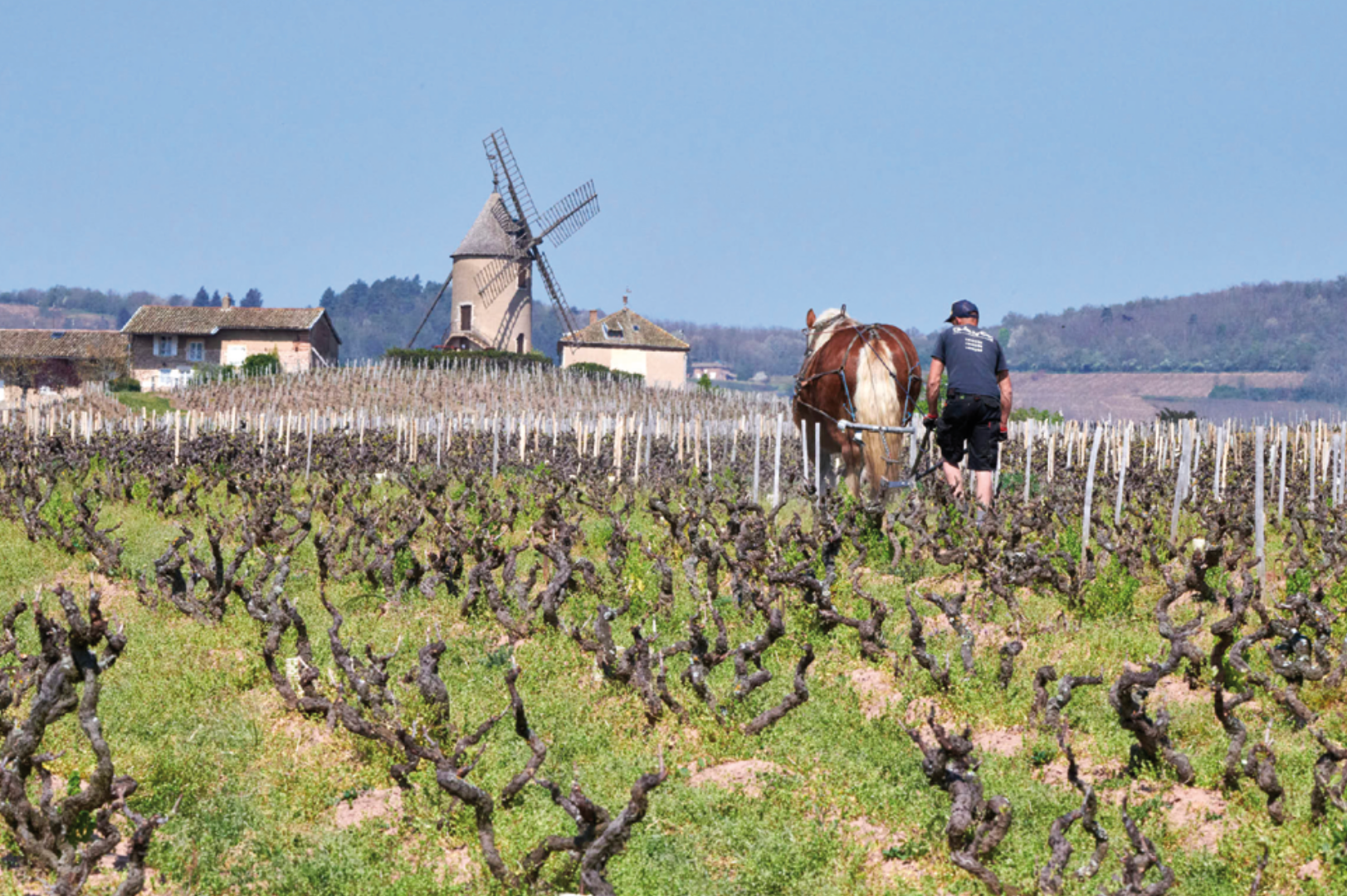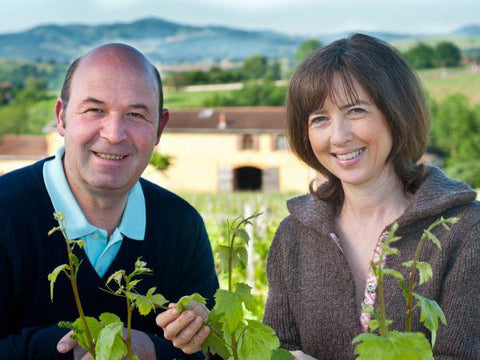Cru Beaujolais: Focus on Moulin-a-Vent
Of all 10 Crus of Beaujolais, I have decided to start this guide with Moulin-à-Vent.
Why?
It is not at the top or the bottom of the Crus, but is plum in the middle of the northern half of the 10 crus, sandwiched between Fleurie and Juliénas. It’s topography is nothing special: it does not have the highest hills or the steepest slopes.
Now, Moulin-à-Vent does have one large hill that tops out at 258 meters. But that’s nothing too unique:nd there are plenty of hills like this throughout the Crus. The hill is worth mentioning only because of the 15th century windmill that sits at its top and gives the Cru its name.
No, I am starting with Moulin-à-Vent because of the soils that lie beneath the vines. Thanks to those soils, Moulin-à-Vent can produce a wine that many Beaujolais-lovers consider to be the very greatest of all the wines of Beaujolais.
What those Beaujolais-lovers admire is a wine that has a concentration and tannic structure exceeding anything else that you’ll find in the region. Accordingly, the wines can age, and most people report that after about 10 years the wine starts to resemble a wonderfully mature Burgundy or Rhone.
Historically, the marketplace agreed that Moulin-à-Vent was special. Before WWII, Moulin-à-Vent fetched the same prices as premier crus from Vosne-Romanee in Burgundy. Today, very few of us can afford to drink Vosne Romanee, while Moulin-à-Vent rarely sells for more than $30. So it should be no surprise that I believe Moulin-à-Vent offers some of the most undervalued red wines from anywhere in the world.

What makes Moulin-a-Vent so unique?
So what is it about those soils? Moulin-à-Vent is built on a granitic base, but this is true of most of the other Crus in Beaujolais as well.
What really distinguishes its soils is the presence of manganese.
Manganese is a hard grey metal that, in high concentration, can poison and kill the vine. In Moulin-à-Vent there isn’t enough manganese to kill the plant, but just enough to reduce the vines’ grape yield. This results in fewer but more concentrated berries, giving you a bigger wine.
Note that it’s unlikely that any manganese actually gets into your bottle of Moulin-à-Vent. But if it were to, this would be a good thing, as it is known to have a number of healthful properties and is often added to diet supplements!
Manganese is not the whole story, of course. Moulin-à-Vent’s terroir is the result (like all great terroirs) of many factors. The soils also have a high iron content, which is generally associated with more tannic, longer-lived wines.
And of course there are the slopes of the hill – often facing south or southeast – helping sunshine get to the vine to make sure the grapes fully ripen.
All these circumstances do, indeed, ensure that Moulin-à-Vent makes the biggest and most powerful wines in Beaujolais.
It is not just Moulin-à-Vent’s power that impresses me, but also its breadth and majesty. Unlike, say, a Brouilly, which you will gulp down happily, you will find yourself taking your time with a bottle of Moulin-à-Vent, as with each sip different flavors seem to unfold. There is a seriousness here that just demands that the drinker explore further. It is great wine. It’s not the only Cru from Beaujolais that produces great wine like this, but it is often the first to come to mind.

Who are the top producers of Moulin-à-Vent to get to know?
Moulin-à-Vent has great terroir and produces some great wines. What it does not have is a strong stable of artisanal Moulin-à-Vent specialists that are known by wine lovers around the world -- as is arguably the case of Morgon or Fleurie, for example. But don’t worry. There are still specialists you should get to know. And the relative paucity of culty superstars helps keep Moulin-à-Vent incredibly well-priced. There are also a number of delicious wines from producers based elsewhere in Beaujolais but that dabble a little in Moulin-à-Vent.
Here are some of my favorite examples of both:
1. Domaine Diochon is located just across from the famous windmill in the heart of the Cru.
You can shop our Diochon collections from SF and NYC.
It is a small estate, with only about 5 hectares, producing just one wine every vintage. The vines are 50-85 years old (while vine age is always important, I find that it is absolutely critical to giving Gamay the complexity that can make Cru Beaujolais special). This domaine has been producing since 1935, and the wine is made the same now as it was then: in the traditional, semi-carbonic fashion.
Bernard Diochon retired without an heir in 2007, and I felt that there was a hiccup in quality that lasted a couple of years. The 2010 and 2011, however, both lived up to the domaine’s historic very high quality, and every vintage since then has been excellent. You should definitely buy and try current vintages, and also consider putting a few bottles away for up to decade.
Or maybe longer! I bought two magnums of the 2005 when it was released in 2007, planning to drink them both at my son’s first birthday. But first birthday parties tend not to be the drinkiest of events, and we only got through one of the magnums. As for the other...for some reason I never sent it back to storage and it still sits at the bottom of my small wine fridge at home. Perhaps my son, who is 13 today, will be able to enjoy it with me on his 21st birthday?

2. Chateau des Jacques. This is one of the great historic Mouln-a-Vent estates that was making wine back when it was worth more than Vosne Romanee. They are still making wine, but now under the watchful eye of their owners in Burgundy, Louis Jadot, who bought the Chateau in 1996. Before 1996, no Burgundy producer had ever bothered to expand here. Since Jadot blazed this trail, a number of Burgundians have started to head south, where the land remains far cheaper -- including the great Volnay domaine of Michel Lafarge.
The Jacques style is paradigmatic Moulin: long-lived and Burgundy-like. In fact, the wine-making here is much closer to what you’d find at a typical Burgundy estate than down the road at, say, Diochon. There are longer macerations and extended aging in oak barrels, for example. The result is that these really are wines that require aging. (Unlike Diochon, which can be pretty delicious on release.) Good news, you can often find bottles with at least a few years of bottle age in the market place.
3. Chateau de Moulin-à-Vent. Great historic estates seem to be a thing in Moulin-à-Vent, and this Chateau is another one. You can tell by the names: very few domaines around here are named “Chateau,” but Moulin-à-Vent has two of them!
Like Chateau des Jacques, this Chateau makes wines in a Burgundian style that are intended for medium to long-term aging. There is more extraction than elsewhere in Beaujolais, more destemming of the fruit, and even some aging in new barriques, which is by and large very rare in Beaujolais, due to the delicacy of the Gamay grape.
This Chateau’s greatest gift to the wine world, surely, is its range of single-vineyard wines. They have holdings in a number of different parcels in Moulin-à-Vent and they bottle them separately. Always wanted to get into the nuances of the Clos de Londres versus the Couvent de Thorin? Well now’s your chance. Though you’ll need to buy the wines and then age them for a few years to let the oak absorb and the distinctive terroirs shine through.
4. I wanted to give one example of a domaine from outside of Moulin-à-Vent that produces a good wine within, and I have chosen Pierre Chermette and his Domaine de Vissoux. Rare among artisans, the focus for years, even generations, was actually non-Cru Beaujolais -- and he still makes several delicious bottlings from old vines growing outside the ten Crus. But over the years he has acquired a few parcels in the Crus, including three parcels in Moulin-à-Vent.
Chermette blends those three parcels together to produce a Moulin-à-Vent he calls Les Trois Roches. The three “Roches” are for the three different parcels. There is Rochegres ("contributing finesse," according to Chermette), La Rochelle ("for structure"), and Roche Noire ("for vivacity"). Chermette makes the wine in an old-fashioned, natural style. It is more forward than the other examples of Moulin-à-Vent listed above -- it’s delicious young! -- but I’ve still had good success aging it for five or more years.

Shop Moulin-à-Vent in NYC.
Shop Moulin-à-Vent in SF.
Like this blog post? You can learn more about Beaujolais Crus here:
- Starting with Part 1, our introduction to the 10 Crus,
- Part 2 is a focus on Moulin-à-Vent,
- Part 3 is a focus on Morgon,
- Part 4 is a focus on Fleurie and
- Part 5 is a focus on Juliénas.
- In Part 6 we look at both the Côte de Brouilly and Brouilly.
- Part 7 is Chiroubles,
- Part 8 is Régnié,
- And Part 9 finishes up with the two remaining crus, St. Amour and Chénas.
This post was updated 11/20/2020.

